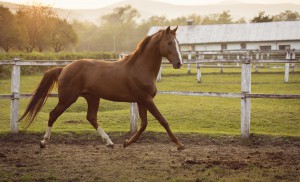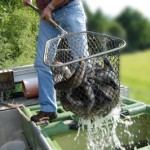 Spring Horse Care Tips – Ready, Set, Ride! Now that the weather has finally warmed up, horse owners are starting to spend more time with their horses, and are looking forward to even more enjoyable riding weather. There are some nutritional concerns, however, during this season, and some management issues we should address to ensure the health and performance of our horses.
Spring Horse Care Tips – Ready, Set, Ride! Now that the weather has finally warmed up, horse owners are starting to spend more time with their horses, and are looking forward to even more enjoyable riding weather. There are some nutritional concerns, however, during this season, and some management issues we should address to ensure the health and performance of our horses.
First, as we start working our horses more, we must increase the plane of nutrition to ensure that the horse’s increased requirements are met. Energy is possibly the most important nutrient to consider in a working horse. As a horse works harder, its energy (calorie) requirement increases, and we must supply those additional calories in a form that will not compromise the horse’s digestive health. We can add more calories by increasing the amount of grain in the ration, but grain is high in starch, and too much starch (and other soluble carbohydrates) may lead to digestive disturbances such as colic and/or laminitis. Safer energy sources include fat and fermentable fibers.
Feeds such as Purina’s Ultium® Competition, Strategy® Professional Formula GX, and Omolene #500® Horse Feed are higher in fat and fermentable fibers, and lower in starch than traditional sweet feeds, therefore are excellent feeds to increase the calories in a working horse’s diet. Omolene #200® Horse Feed is another excellent feed for these situations, as more of the calories are supplied by fat, and less by starch. These performance feeds also contain the amino acids, vitamins and minerals to support the increased demands of the performance horse. Keep in mind that all feeding changes must be made gradually, so it is important to gradually increase the amount of feed as the horse’s work load increases.
If you are not planning to ride your horse hard, however, or your horse is naturally an easy keeper, a concentrated feed such as Nature’s Essentials® Enrich 32® Supplement may be the best way to meet the horse’s nutritional needs without adding many calories. If your horse stays in good body condition (not too fat or too thin) on just hay or pasture, feeding one to two pounds of Nature’s Essentials® Enrich 32® or Enrich 12® Supplement will provide the protein, vitamins and minerals that the horse needs to stay healthy.
Next, we need to keep in mind that the forage portion of the horse’s diet may be changing, and we must be aware that some of these changes may be problematic for some horses. For some horses, the advent of spring means that the source of forage changes from hay to fresh grass. If this is the case, the horse owner should take care to minimize the risk of laminitis as horses are exposed to fresh pastures.
Why can fresh grass cause laminitis in horses? During the process of photosynthesis, plants manufacture sugars that are either used for metabolic processes such as growth, or are stored as polysaccharides such as starch or fructan. The storage form of the sugars depends on the plant species. In certain situations, such as the warm sunny days and chilly nights that we see in the spring and the fall, the plants use fewer sugars for growth, and therefore store more as polysaccharides. This can cause problems for horses, especially when the sugars are stored as fructan, because fructan does not appear to be digested in the horse’s upper gut (where starch is digested and absorbed), but instead passes into the hindgut where it is fermented by the microbes. It is this fermentation of fructan that appears to be a trigger factor for colic and/or laminitis, similar to a grain overload in horses. The fermentation of fiber carbohydrates in the hindgut is normal, and does not cause digestive disorders in the horse.
Other environmental conditions that can affect the amount of polysaccharide storage in plants include drought stress, duration and intensity of sunlight, salinity (salt content) of soil, and overall health of the plant. Again, some species of grass, including cool season grasses, tend to store sugars as fructan, while others, the warm season grasses, tend to store sugars as starch and are less likely to cause problems.
How then do we manage pastures to minimize the risk of laminitis? Horses that are kept on pasture year-round usually adjust to the new grass as it grows. Nature does a fairly good job of making the pasture change gradually. The problems usually occur when horses have been confined and fed a hay and grain diet during the winter, and are then abruptly turned out on the lush green pasture in the spring. Further, horses that have been kept up through the winter may overeat when turned out because of the palatability of the lush green foliage. This sudden change in the diet, especially when it includes a rapid influx of the unfamiliar fructan into the hindgut, may trigger digestive upset.
There are several ways to prevent or minimize problems when introducing horses to spring pastures. Feeding hay immediately before turn-out may help keep horses from overeating, since they are less likely to overeat on an already full stomach. Restricting grazing time will also help minimize risks. A suggested schedule is: thirty minutes of grazing once or twice a day on the first day of grazing; then increase grazing time by 5-10 minutes per day until the horses are grazing 4-6 hours per day total. At this point, they have adapted to the green grass.
One final consideration when getting back into the saddle is the condition of the horse. On that first warm sunny day, it is very tempting to head out to the barn for a nice, long trail ride to enjoy the great weather. However, if you have not been riding your horse regularly through the winter, your horse is not conditioned for that type of physical activity (and possibly neither are you!). To prevent muscle soreness, and possibly “tying-up”, horses should be gradually reintroduced to work. Start with slow, easy work and short workouts, and gradually increase the intensity and duration of the workouts until your horse is adequately conditioned. This will help decrease the risk of problems and injuries in your horse. It may take up to 90 days to get a horse properly conditioned for strenuous physical workouts.
Once your horse’s nutritional and management considerations are addressed, and your horse is adequately conditioned for the desired workload, you are ready to head out and enjoy the season!
Source: By Dr. Katie Young, Consulting Equine Nutritionist, Purina Mills, LLC


